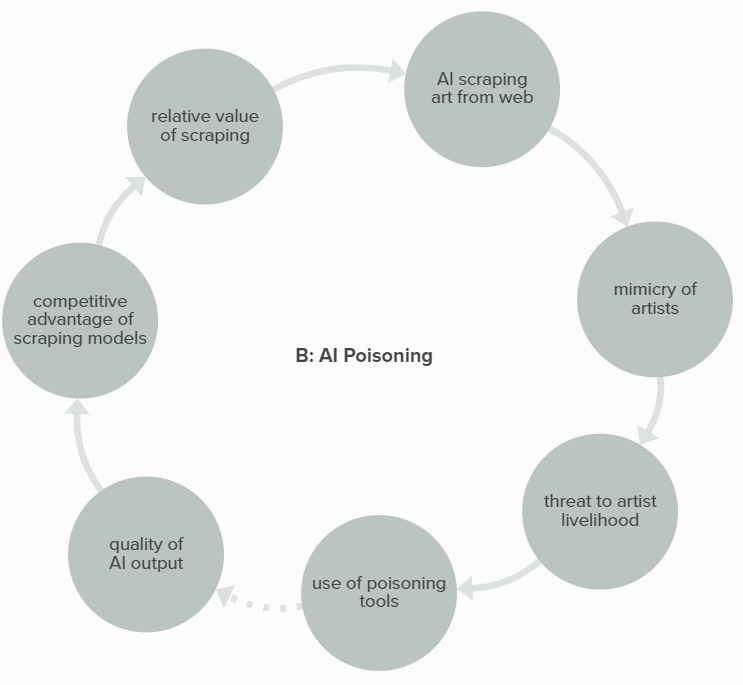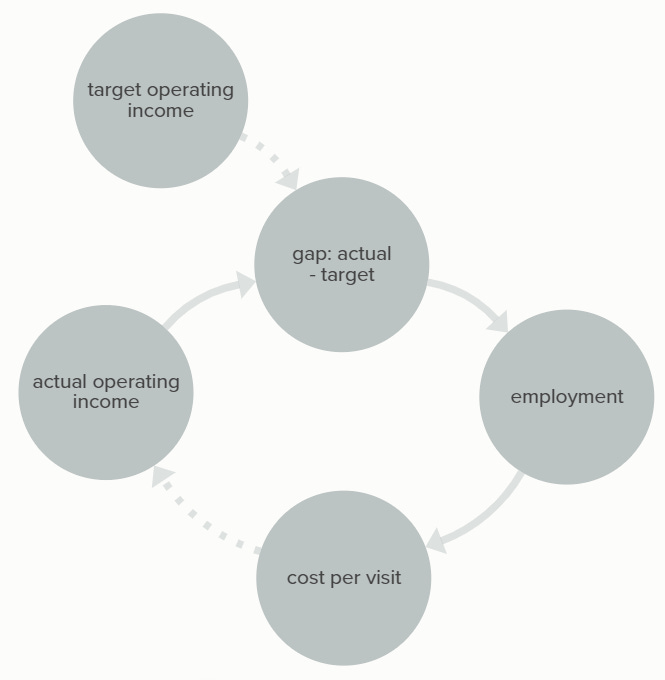Complementing last week’s coverage of reinforcing loops, this week tackles balancing loops. This is the other archetypal story that can arise from a loop’s structure: rather than growth or decay, this is a story about control and balance. Again, this isn’t inherently good or bad — a body or an ecosystem staying in balance feels different than an authoritarian regime maintaining control over society. This story applies whenever there’s an odd number of “opposite” connections in a loop. Other names include negative feedback loops1 and stabilizing loops. Balancing loops are notated in one of a few ways: -, B, or ⚖2.
As the Kauffmans point out in chapter 3 of their book, the balancing that these systems constantly engage in requires a lot of energy. Sometimes this is provided by the system itself, like the way waves in the ocean all eventually level back out through simple gravity. Often, though, it’s energy that has to be fed into the system - for example, most of the calories a person uses in a day are spent on just staying alive, rather than the activities of daily living, exercise, etc. This expenditure of energy to maintain homeostasis can make the systems difficult to change and make it hard to effectively intervene. Kauffman’s example is opening a window to cool down a house: if you’re trying to cool it past the setting on the thermostat, you’ll be fighting the furnace the whole way and wasting a lot of energy3.
This also shows the importance of information systems in balancing loops: if the accurate perception of monitoring systems is corrupted, the system struggles4. One manifestation of this is when there is a delay in a loop: babies take decades to mature, the employment numbers don’t come in until the next month, etc. Because the system is constantly reacting to things that happened some time ago, expect to see oscillations around the system’s goal/equilibrium state. Reducing the oscillations requires more energy: investment in more precise equipment, more diligent monitoring, etc.
Diagramming Balancing Loops
For an example of a balancing loop without an external goal, consider the example of AI image poisoning. The more data image-generating AI scrapes from the web, the better it mimics the style of artists in its training corpus. The closer the mimicry, the higher the threat to the artists’ livelihood. The higher the threat, the higher the use of poisoning tools like Nightshade and Glaze. As the use of these tools increases, the quality of these AI models decreases. As the quality decreases, the competitive advantage of the models decreases. As the competitive advantage decreases, the relative value of free images from the web vs paying for a corpus decreases, and the less these models scrape from the web. Left to itself, some equilibrium will be reached.
Many human systems, though, have explicit goals. For example, Amazon recently announced layoffs for some of its healthcare businesses. Amazon has set a target for One Medical to lower its operating loss. As the gap between the actual and the target becomes more negative (bigger operating loss), the response is to lower employment (layoffs). Decreased payroll decreases the cost per visit, which increases the actual operating income and closes the gap (the signed gap increases, becoming less negative, though its absolute value decreases).
I noted last week that this name has fallen out of favor because of the implicit value judgment.
Any little icon of scales would do, but this is the first case I have encountered of emoji-based futures work.
Personal connection: when my wife and I were young, we lived on the bottom story of a two-story house that had been converted to apartments. We felt like the apartment was never warm enough, even though we had the heater on, and we felt like the heating bill was pretty high. Once we talked to the upstairs neighbor about it, and we learned that the furnace had been heating the upper apartment so much that they had to keep the windows open in the middle of a Nebraska winter. I don’t really understand what all the design defects were that led to this situation.
As another HVAC example, whenever we use our fireplace for a little extra warmth/cheer/hygge, it’s close enough to the thermostat that the heat will never come on and the rest of the house becomes significantly colder.



